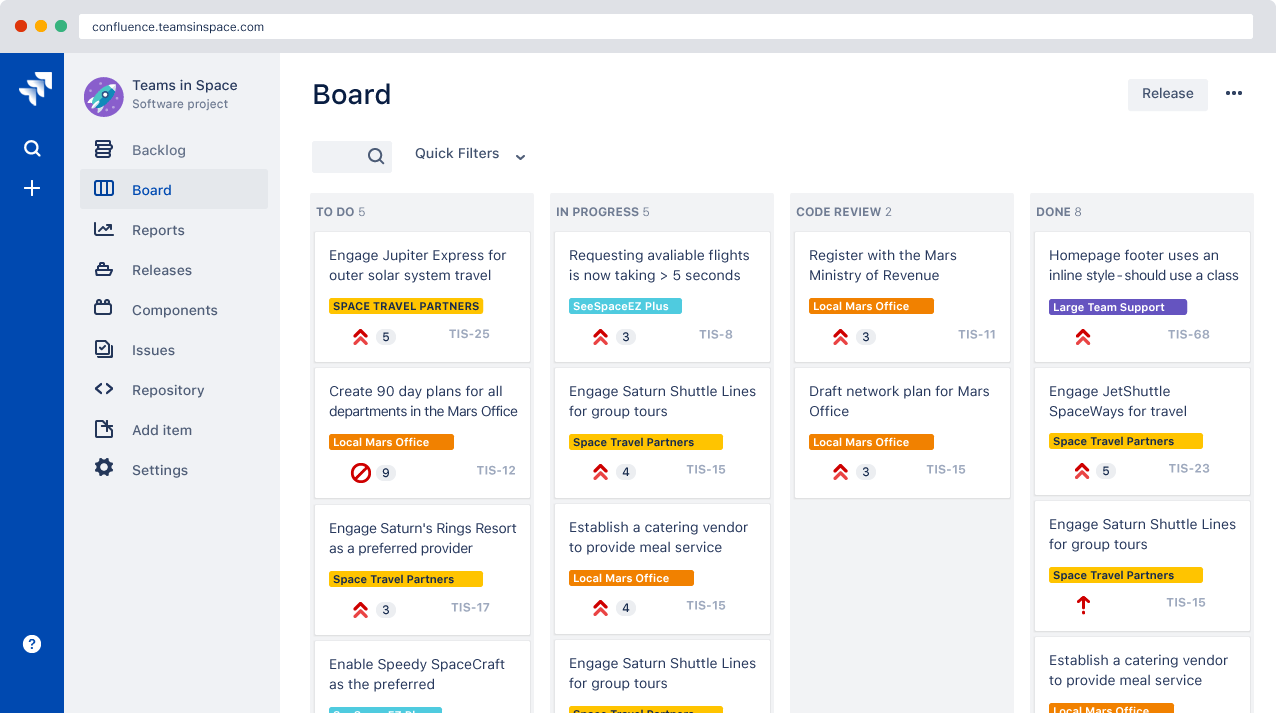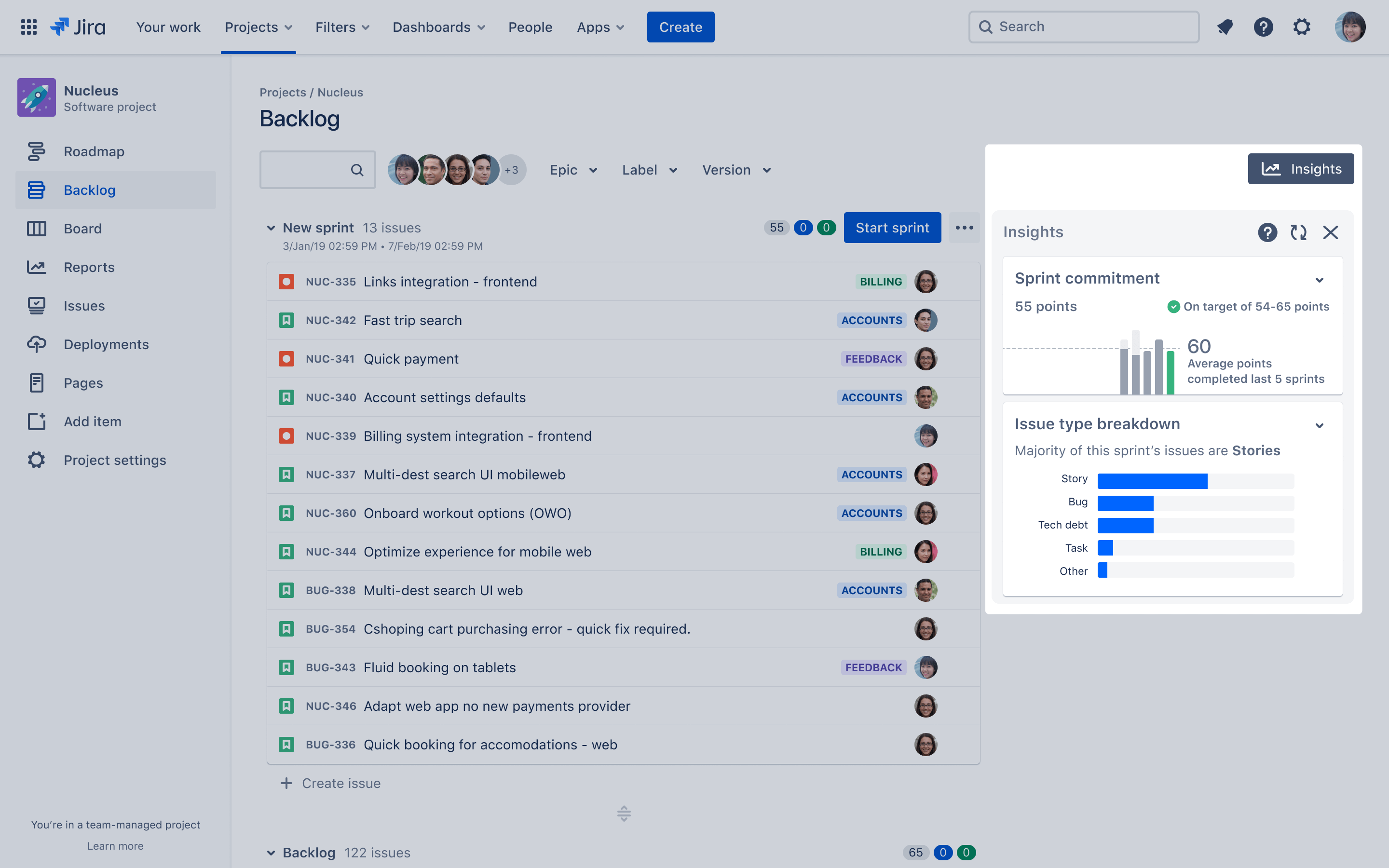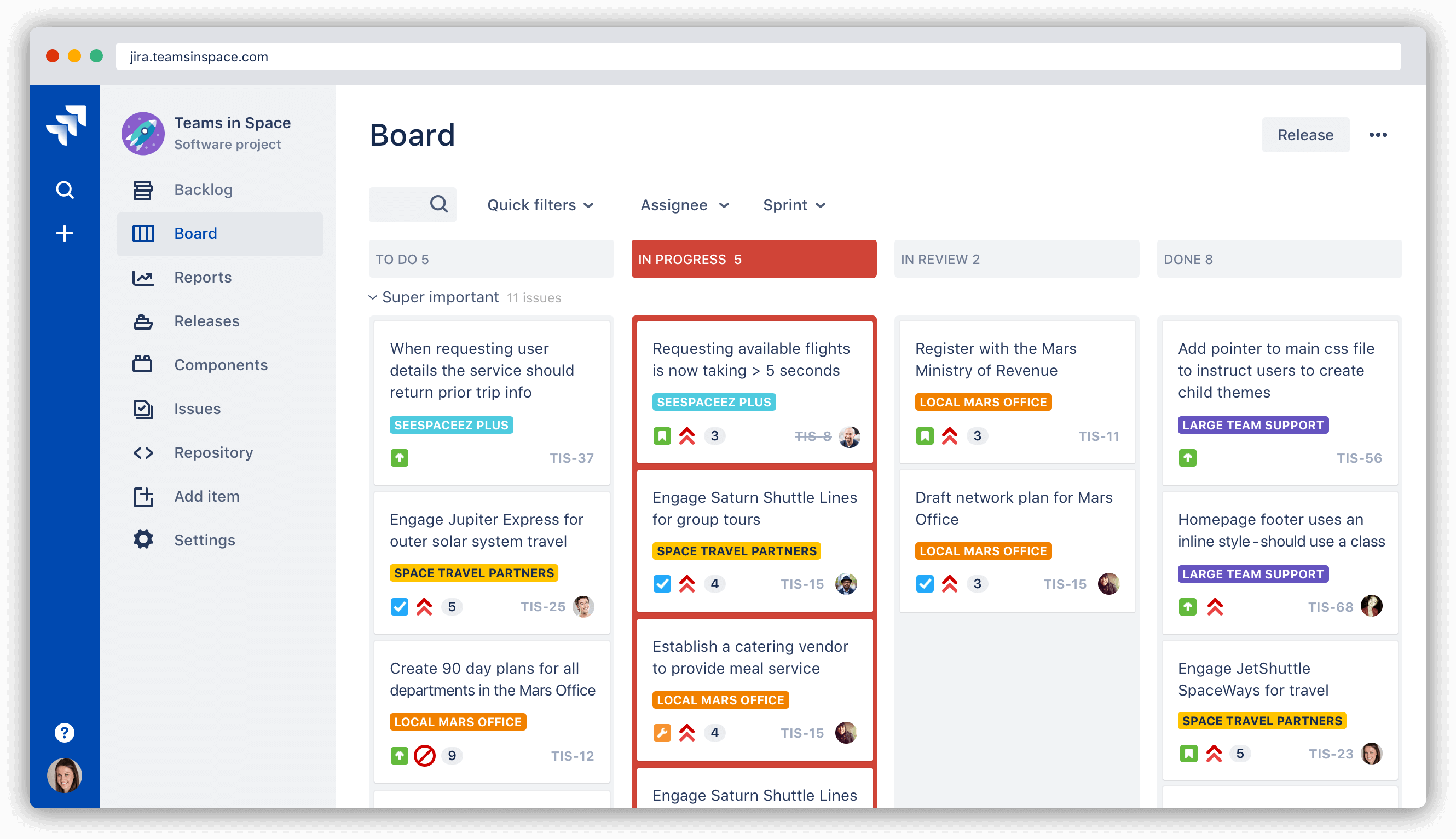Fit your framework
Jira is an agile project management tool that supports any agile methodology, be it scrum, kanban, or your own unique flavor. From agile boards, backlogs, roadmaps, reports, to integrations and add-ons you can plan, track, and manage all your agile software development projects from a single tool. Pick a framework to see how Jira can help your team release higher quality software, faster. Want to learn more about agile? Visit The Agile Coach, Atlassian’s no-nonsense guide to agile development.
Agile tools for scrum
Scrum is an agile methodology where products are built in a series of fixed-length iterations. There are four pillars that bring structure to this framework: sprint planning, stand ups (also called daily scrums), sprints, and retrospectives. Out-of-the-box, Jira comes with a comprehensive set of agile tools that help your scrum team perform these events with ease.
Tools for sprint planning
Sprint planning meetings determine what the team should complete in the coming sprint from the backlog, or list of work to be done. Jira makes your backlog the center of your sprint planning meeting, so you can estimate stories, adjust sprint scope, check velocity, and re-prioritize issues in real-time. There are several tools within Jira's scrum template that can help your sprint planning run smoothly.
Version management
Track versions, features, and progress at a glance. Click into a version to see the complete status, including the issues, development data, and potential problems.
Easy backlog grooming
Easily re-prioritize your user stories and bugs. Select one or more issues, then drag and drop to reorder them in your backlog. Create quick filters to surface issues with important attributes.
Sprint planning
Make your backlog the center of your sprint planning meeting. Estimate stories, adjust sprint scope, check velocity, and re-prioritize issues in real-time with the rest of the team.
Story points
Estimate, track, and report on story points to help your team become more accurate in future sprints. Use story points, ideal hours, or your own method of estimating.

Scrum board
Scrum boards are used to visualize all the work in a given sprint. Jira's scrum boards can be customized to fit your team's unique workflow. You can also easily add things like swimlanes to separate epics, assignees, projects, and more. At the end of the sprint, get a quick snapshot of all the issues that were completed and any unfinished issues will automatically move into the backlog to be addressed in the next sprint planning meeting.
See insights in the context of your work
As you plan
During your sprint
When you ship


Track and manage your sprints
A sprint is a fixed-length iteration of work, typically one or two weeks in length. Work should be fully scoped and prioritized during the sprint planning meeting, so the team can get started as soon as the sprint begins. These features keep track of all the work being tackled in each sprint, so your team can stay focused on the tasks at hand.
Sprint permissions
Use sprint permissions to define what users can see or do in a given project. Sprint permissions allow you to better delegate permissions and responsibilities to team members, allowing the entire team to be more autonomous and agile.
Custom issue types
Develop custom issue types for bug tracking, stories, coffee runs, and everything in between. Configure a custom workflow and custom fields for each issue type, so your team can manage work according to its requirements.
Workflows
Create and assemble your own custom workflow states and transitions for every issue type (bugs, stories, epics, coffee runs). Leverage the powerful Jira workflow engine to update issues automatically based on events in other systems, or define criteria that must be met before an issue can progress.
Release hub
Quickly see what's shipping in your next release, and what's left to do to get it out the door. Easily reconcile your source code and issues: automatic warnings are generated for issues with broken builds, missing code, or open pull requests.
Daily scrums or stand ups
Also known as daily scrums, stand ups are short mini-meetings where the team gathers to go through a quick list of what's been done, what they will work on next and where they require someone's input or help. Jira helps your team get a quick snapshot of the work in progress, so you can come prepared to discuss the most critical items for the day.
Sprint permissions
Use JQL, or Jira Query Language, to quickly and accurately search Jira for issues assigned to you, updated in the last 24 hours, or anything that is critical at the moment, so you can go into your scrums armed.
Custom Dashboards
Keep an eye on progress and identify bottlenecks by customizing your own Jira dashboard. Use the Wallboard to display your dashboard on a TV so the whole team can keep up to date.
Better retrospectives with scrum reports
Jira has a number of agile reports specific for scrum teams. For example, Burndown and Velocity charts, give your team critical insight into their agile process. Reports make retrospectives more data-driven and highlight areas to improve for upcoming sprints.
Burndown chart
Track the total work remaining and project the likelihood of achieving the sprint goal. This helps your team manage its progress and respond accordingly.
Sprint report
Understand the work completed or pushed back to the backlog in each sprint. This helps you determine if your team is overcommitting or if there is excessive scope creep.
Velocity chart
Track the amount of work completed from sprint to sprint. This helps you determine your team's velocity and estimate the work your team can realistically achieve in future sprints.
Cumulative flow diagram
A cumulative flow diagram shows the number of issues in each status. The team can easily spot blockages by seeing the number of issues that increase in any given state.
Release burndown
Track the projected release date for a version. This helps you monitor whether the version will release on time, so you can take action if work is falling behind.
Control chart
See the cycle time for your product, version or sprint. This helps you identify whether data from the current process can be used to determine future performance.
Epic burndown
Track the projected number of sprints required to complete an epic. This helps you monitor whether the epic will release on time, so you can take action if work is falling behind.
Agile tools for kanban
Kanban methodology is based on the idea of continuous releases. Work is tracked using a kanban board that displays the statuses of work in columns and lanes. There are four important pillars to kanban to help teams ship products: continuous releases, WIP (work in progress) limits, the list of work, and columns or lanes. Here are some tools that come out-of-the-box in Jira's kanban template to help you run kanban with your team.
Features for kanban
One benefit of kanban is that your team can get started with almost no overhead. With Jira, you can set up your kanban board with one of our default workflows and start adding issues or stories immediately. Once your team gets used to the board, you can start to customize your project, workflow, and issue types to fit your team's needs. Here are some features that you can configure in Jira.
Story cards
Your kanban board will display the most relevant information for each story, issue, bug or task. Click in to get all the details, including related source code and pull requests, priority, comments, attachments and more.
WIP limit configuration
WIP (Work in Progress) limits can be set to restrict the number of stories in each status at a time. This is important to prevent particular states from becoming bottlenecks and that issues flow smoothly through your workflow.
Swimlanes and columns
Configure columns to represent major workflow states such as To Do, In Progress, and Done. Add swimlanes to group work into streams by epics, assignees, or projects or whatever makes sense for your team.
Flexible workflows
Define and configure different workflows for different issue types or map all issue types on your board to a single unified workflow. Jira's workflows can be as simple or as complex as you like and change as your team grows.

Kanban board
Kanban boards give your team full visibility into what’s next, so when one work item (or card) is completed, the team can quickly move on. Historically, a kanban board was a physical board with Post-it notes or cards to represent the work items. Jira kanban boards contain all the details for each work item, while only displaying the most pertinent information on the board itself.
Agile reports for kanban
Jira has a number of out-of-the-box reports and pre-installed gadgets to help your team track cycle time for your product releases. See statuses of issues over time or if data from your current process can be used to predict future performance. Gadgets can display summary information about project/issue data on your dashboard, providing a central location for quick access to this information. Here are some of the kanban reports that come with Jira.
Cumulative flow diagram
A cumulative flow diagram shows the number of issues in each status. The team can easily spot blockages by seeing the number of issues that increase in any given state.
Control chart
See the cycle time for your product, version or sprint. This helps you identify whether data from the current process can be used to determine future performance.
Mixed methodologies
Some agile teams have adopted mixed methodologies to support how their team works. For example, scrumban takes fixed length sprints and roles from scrum and the focus on WIP (work in progress) limits and cycle time from kanban. Or kanplan, which is kanban with a backlog. Jira features can be mixed up to help these teams without constraints of their tools.
Here's a break down of our agile features and what agile methodology they support. Not sure which framework is right for you? Learn more about agile project management.
Agile at scale
Implementing agile at the individual team level is relatively easy and the results are compelling. But extending it across multiple teams in large organizations presents a number of challenges in the areas of coordination, collaboration, managing dependencies, and more.
Wherever you find yourself on your agile journey–whether you’re spreading agile adoption across a group of coordinated teams or applying the use of a scaled agile framework like SAFe or LeSS–we’re here to help. Check out our agile at scale solutions page to learn more.
For more insight on the topic of agile at scale, visit the Agile Coach.

